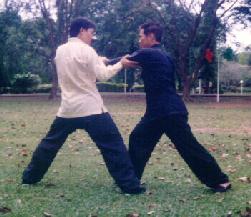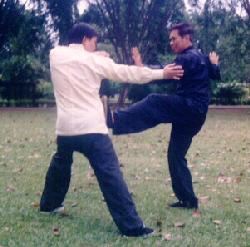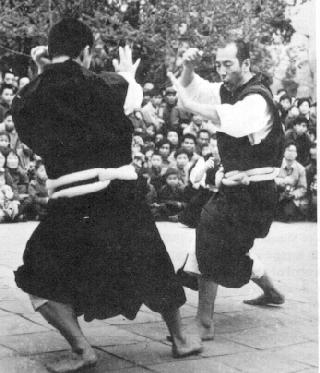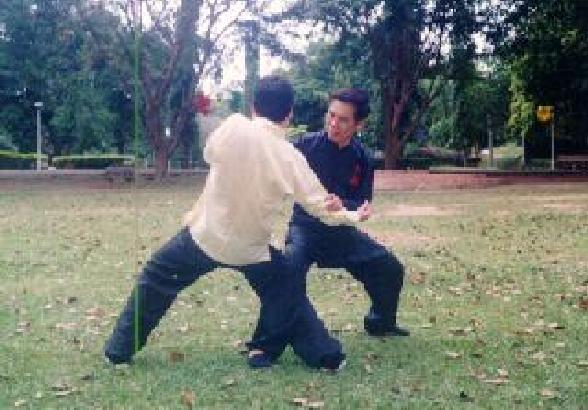May 2001 (Part 3)
SELECTION OF QUESTIONS AND ANSWERS


Combat Application of Taijiquan. Goh Kok Hin grasps Sifu Wong's arm and pulls him to fall forward, using a Shaolin pattern called “lead Horse Back to Stable”. Sifu Wong moves his right leg diagonally forward and simultaneously executes a thrust kick with his left leg, using a Taijiquan pattern called “Cross Hands Thrust Kick”.
Question 1
I bought a tape call “Tai Chi for Health” and started practising. At that time the only thing I knew about Tai Chi was that it was good for health and also it calms you down. Now I know it is a martial art, but I have never seen any applications of it.
— Jose, Dominican Republic
Answer
The correct term is Tai Chi Chuan, or Taijiquan in Romanised Chinese. Tai Chi Chuan is a martial art, but today it has degenerated into a form of gentle exercise or dance. In this debased form, it is often called Tai Chi by many people, especially by those who do not even know it is actually a martial art.
The important point is that even if you, like most people, are not interested in fighting but if you wish to have radiant health and vitality, you have to practise Taijiquan as a martial art. If you practise it as a dance, you will at best get the benefits of what a dance will give; whereas if you practise it as a martial art, you will get from it the benefits of a great martial art.
Tai Chi dancers have such benefits like relaxation, loosening of muscles, and graceful movements. These benefits are nice, but they are nothing when compared to the great benefits enjoyed by Taijiquan martial artists.
For example, Taijiquan martial artists are mentally fresh and full of energy, whereas some Tai Chi dancers may still be sickly and in pain. Taijiquan martial artists can spar for a few hours, but Tai Chi dancers often become tired and out of breath after a few minutes of vigorous movements. Indeed, my impression is that many people turn to Tai Chi dance because they lack the vigour and stamina to do vigorous exercises like tennis and jogging.
Most people, including most Tai Chi dancers all over the world, have never seen combat applications of Taijiquan because genuine Taijiquan is very rare today. Even in China what is practised is usually Tai Chi dance. My Intensive Taijiquan Course is an attempt to preserve the wonders of Taijiquan as a martial art.
Taijiquan is indeed wonderful. Not only its very effective combat applications are graceful and gentle — far from the brutality of many other martial arts — its training as a martial art brings good health, vitality and spiritual joy — whereas many other martial arts are detrimental to health, wear down your energy, and may make you hostile and aggressive.
Question 2
I know that a tape is no substitute for a good teacher but Tai Chi schools are far away from my house, and I could only go on Saturdays if I want to take classes. Do you think I can learn something with the tapes? I know that later I have to find a good teacher.
Answer
If you are a beginner, you cannot learn Taijiquan from tapes, because the essence of this great martial art is not merely performing its external form, but using the form to train energy and mind. You can learn external forms from tapes, but training energy and mind has to be learnt from a living master.
But before you can find a genuine Taijiquan master who is willing to teach you, it is recommendable to acquaint yourself with the external form first. Learning from tapes will then be useful.
Probably the Tai Chi schools you mentioned teach only Tai Chi external form. But if they teach genuine Taijiquan, it is worth your time and effort to learn from them. One thing you must be very clear about. If you want to learn Taijiquan, you have to put in a lot of time and effort; otherwise you have to be contented with Tai Chi dance.
Question 3
I have downloaded some applications of Tai Chi techniques or movements from the short form of the Yang style.
Answer
Taijiquan is an internal martial art. This apt description indicates two essential aspects of Taijiquan, namely internal force and combat application. Without internal force, Taijiquan ceases to be internal; without combat application, it ceases to be martial. The sad thing about this great art is that in most of Taijiquan practised today all over the world, there is nothing internal and nothing martial.
Like internal force training which involves the training of energy and mind, combat application needs to be taught by a master. You may know how to perform the methods which you may read from a book, but you may still have no internal force. Similarly, you may know how to perform the techniques which you may copy from a videotape, but you may still be unable to overcome an opponent.
For example, you may learn from my webpages how to use “Golden Cockerel Stands Solitarily” to overcome a Muai Thai knee attack, or how to use “Jade Girl Threads Shuttle” to overcome an elbow strike, but when a Muai Thai fighter attacks you with a knee strike or an elbow strike, you would be hit. Why? There are many reasons.
One main reason is that the techniques are just one of the factors for combat efficiency. Other factors include force, speed, timing and spacing. Techniques are a visible factor, which you may learn from a videotape or a webpage. Force, speed, timing and spacing are invisible factors, which have to be nurtured, not just taught, by a master.
Even for techniques, combat situations are so varied and changing that individual coaching is usually necessary. For example, in the “Golden Cockerel” pattern against a knee strike, how you hold up your hands, raise your knee or position you standing foot varies according to different opponents and conditions. There is so much variation and so many possibilities that it is not possible to mention all of them in a book.
Would a master be able to teach all these variations and possibilities? He does not have to. By teaching a selected few, a master would be able to inculcate the underlying principle which will enable the student to know what to do in different situations.
Can this be done through books, webpages or videotapes? No, such teaching is too subtle to be satisfactorily expressed in words, it has to be demonstrated by the master and experienced directly by the student. For example, the master may say, “Apply this amount of force.” How would you express correctly “this amount” in words?
Hence, at best you may be able to perform the downloaded techniques, even beautifully, in solo demonstration. If you are contented to perform them as Taiji dance, that is fine. But you will be unable to apply them in combat, which is the real objective of the techniques.
However, if you are trained in genuine Taijiquan, like those who have attended my Intensive Taijiquan Course, then the techniques learnt from books, wehpages and videotapes will be very useful.

A demonstration of Shorinji Kempo in combat. Shorinji Kempo is the Japanese term meaning Shaolin Temple Kungfu
Question 4
Is it true that for one movement like, for example, “Single Whip”, can be applied for different situations?
Answer
Yes, it is true, if you learn genuine Taijiquan. The “Single Whip”, for example, can be used to strike an opponent, to break his arm, to dislocate his wrist, to release a hold, to stop his kicks, or to neutralize his throws.
Question 5
I would like to have your opinion on the Japanese martial art called Shorinji Kempo. It is said to be a modern re-organization of Shaolin Kungfu, and I wonder how far it is from the traditional Shaolin techniques and training methods.
— Mauro, Italy
Answer
“Shorinji Kempo” is the Japanese pronunciation for the Chinese “Shaolinsi Quanfa”. The words, in Japanese and Chinese, are exactly the same but the pronunciation is different. In English it means “Shaolin Temple Kungfu”.
Shorinji Kempo was developed by the great Japanese master Shin Nakamichi who learned Shaolin Kungfu in China from a Shaolin monk called Wen Tai in the 1930s. On his return to Japan in 1946, Master Shin Nakamichi established Shorinji Kempo which eventually became the most popular style of martial art in Japan with about 3000 branches and a million followers.
Master Shin Nakamichi returned to the Shaolin Monastery numerous times to pay respect. In 1980 he erected a stone tablet in the Forest of Stone Tablets in the Shaolin Monastery to commemorate his “honourable return to the source”.
Shorinji Kempo is the authentic Japanese version of Shaolin Kungfu. As in the original Shaolin Kungfu, Zen plays an integral part in Shorinji Kempo training. Also as in Shaolin Kungfu, all the four categories of attack — striking, kicking, felling and gripping — are used in combat. Shorinji Kempo is excellent for combat as well as for spiritual cultivation.
Nevertheless, one could observe some characteristic differences between Shorinji Kempo and traditional Shaolin Kungfu. The fist is more often used in Shorinji Kempo, and the application is comparatively “hard”.
Question 6
Is there any way to help a victim of the dreaded cycle of destruction (pressure point fighting)? Is it possible to revive him using the same pressure point theory that was used to do the damage in the first place?
— Peter, India
Answer
Attacking an opponent's vital point is known as “dian xue” in Mandarin, or “dim mak” in Cantonese. It is not a myth as some people believe, but a real art. My own master, Sifu Ho Fatt Nam, used this art in his fighting.
“Dian xue” or “dim mak” is actually a compassionate art. Instead of bashing an opponent's head or breaking his neck to end a combat, which will cause fatal injury, a compassionate master temporarily disables the fighting ability of his opponent by using “dian xue”, which stops the energy flow to certain targeted areas of the opponent.
By restoring the energy flow, which can be done by the master himself or by another master sought by the victim, the victim's normal functions will be restored. But if the energy stoppage is not rectified, serious injury, disability or death may occur. Hence, when a disciple is taught “dian xue” by his master, he is also taught the remedial methods to help the victim recover.
The same vital points, other vital points or other methods can be used to recover the victim. But it is not just knowing which vital points to work on. If you work on the right points wrongly, you would aggravate the effect.

Taijiquan is very different from Aikido, and in my opinion Taijiquan is far superior.
Question 7
Since it is the meditative part of kung-fu (qi development) that I appreciate more, I believe kung-fu not only can be used for destruction but also for preservation.
Answer
The mind dimension and the energy dimension, or “shen” and “qi”, are two of the three dimensions of kungfu, and become increasingly important in high level kungfu. The third dimension is “jing”, which is the physical dimension.
Speaking in an analytical way, the meditative part of kungfu concerns the mind dimension. But speaking in such a way is uncharacteristic in kungfu, where the three dimensions are regarded holistically. In practical terms, when one practises genuine kungfu, he does not merely practise the physical form, he also involves mind and energy in an integral manner.
Although acquiring combat efficiency is a fundamental objective in practising kungfu, kungfu is constructive and not destructive. A basic tenet in kungfu training is “xian jiang shen, hou fang shen”, which is “first be healthy, then be able to defend yourself”. When one understands this tenet, he will understand why in kungfu philosophy it is considered silly to “take punishment” (like deforming one's hand) in solo training, or exchange punches and kicks in free sparring.
On a personal note, I am proud to say that although I have been involved in numerous fights in my young days, I have not hurt anybody! I was able to do this because I am trained in qin-na, an advanced Shaolin art that temporarily disables an opponent's fighting ability without damaging him permanently.
On the other hand, employing my one-pointed mind and internal force that I have acquired in my kungfu training, I have helped many people recover from so-called incurable diseases as well as saved quite a few from dying.
Question 8
Sifu, I'd like to ask you to give some opinions on the differences and similarities between Aikido and Taijiquan.
— Oisin, Finland
Answer
Both Taijiquan and Aikido are regarded as “soft” martial arts, as distinct from “hard” martial arts like Shaolin Kungfu, Karate and Taekwondo. Their movements are graceful and flowing, with little or no exertion of muscular strength.
Another similarity is their emphasis on energy, called “qi” in Taijiquan and “ki” in Aikido. Indeed the term “Aikido” means “the Way of Harmonizing Energy”.
“Taijiquan” is in Romanised Chinese, it is frequently written as “Tai Chi Chuan” in English. “Qi is in Romanized Chinese; it is commonly written as ”chi" in English. Note that the chi in “Tai Chi Chuan” is different from the chi in “chi kung”. The chi in “Tai Chi Chuan” is actually written as ji in Romanized Chinese, and it means “ultimate”. The chi in “chi kung”. is actually writtern as qi in Romanized Chinese, and it means “energy”. “Tai Chi Chuan”, which is “Taijiquan” in Romanized Chinese, means “Grand Ultimate Kungfu”. “Chi kung”, which is “qigong” in Romanized Chinese, means “energy work”.
Although both arts emphasize energy, their scope and depth are vastly different. What Aikido regards as the energy dimension, is in my opinion merely the use of momentum and leverage, rather than muscular strength, for one's best advantage.
Let us examine a typical attack and a typical Aikido response. When an opponent executes a right thrust punch, instead of blocking it head on, an Aikido exponent would move his body to his left or backward to avoid the punch, grasp the attacker's wrist with both hands, pull the attacker's arm forward following its punching momentum, turn right around and move in a circular way, using his left upper arm to press against the attacker's arm for leverage, and with his left leg as a trap swing the opponent to the ground, then twist the attacker's wrist upward to control him.
Such Aikido moves, while effective in overcoming the opponent without resorting to the use of much muscular strength, operate at the physical level, and not at the energy level as understood in Taijiquan. In other words, even if you have no idea of qigong (chi kung) or energy management, but if you make advantageous use of body mechanics, especially momentum and leverage, you can employ these moves to counter the opponent's attack.
Such moves are seldom used in Taijiquan because since there are many steps involved, the opponent can frustrate the Aikido counter by intercepting any one of these steps. An innate weakness in Aikido combat philosophy is a tacit presumption that while the Aikido exponent carries out these many steps in his counter, the opponent does not know what to do. In Taijiquan the combat philosophy is reversed — a Taijiquan exponent always presumes that his opponent is capable.
Suppose the Aikido exponent grasps the wrist of a Taijiquan exponent in the above example. The Taijiquan exponent has numerous alternatives. He may, for example, move a slight step forward following the momentum of the Aikido exponent's pull, simultaneously make a small circular movement with his wrist to release the grip and to lift up the opponent's two arms, and strike the Aikido exponent's exposed ribs with his other hand in a Taijiquan pattern called “Jade Girl Threads Shuttle”.
Or, the Taijiquan exponent may move a big step forward following the momentum of the pull, bend his elbow and strike his elbow into the Aikido exponent, using the Taijiquan pattern “Elbow Strike”. Or he may move one leg behind the Aikido exponent's legs, and spread his right arm, felling the Aikido exponent backward, using the pattern “Wild Horse Spread Mane”.
Now, let us compare what a Taijiquan exponent would do when an opponent executes a right thrust punch at him. The Taijiquan exponent has many counters. He may counter with the “peng technique” of “Grasping Sparrow's Tail”. This “peng technique” looks like a block, but it is much more. Its purpose is not just to ward off the punch, but executed at the right time when the punching arm is fully extended, and at the right spot at the opponent's elbow, it can dislocate or fracture the opponent's elbow at the time when he thinks his punch has connected.
If the Taijiquan exponent wishes to fell his opponent or control his opponent's wrist like what the Aikido exponent did, he can do so, but in one step instead of four or five. As the punch approaches, he lowers his stance to “swallow” the attack and simultaneously applies the “lu technique” of “Grasping Sparrow's Tail”, felling the opponent on the spot and controlling his wrist.
Both the Aikido exponent and the Taijiquan exponent do not use brutal strength to subdue their opponent. But how they achieve this is different. The Aikido exponent takes advantage of leverage and momentum, and to manoeuvre his opponent into a difficult position so that he has this technical advantage, he has to use many steps.
The Taijiquan exponent uses only one step. He can do so because he makes use of flowing energy, and not just leverage and momentum. He can fell an opponent on the spot without having to manoeuvre him first because his management of flowing energy can generate tremendous internal force to accomplish the task. He can dislocate or fracture an opponent's elbow because this tremendous force can be marshalled instantly at the point of contact.
A Taijiquan exponent may also manoeuvre his opponent, but he does so for tactical instead of technical considerations. In other words, the techniques he uses to subdue his opponent do not require many steps to complete, but he still uses many steps instead of just one or two, for other purposes, such as to access the opponent before actually engaging him in combat, or to lay a trap before executing the coup de grace.
There are many other differences between Aikido and Taijiquan, but space limitation permits mentioning briefly just two more. Aikido is a sport, protected by safety rules. Someone overlooking this fact may risk his life in a real fight. For example, a police officer trying to apply several Aikido moves to apprehend a crook may have a knife pierced into his side. Taijiquan is a serious art for life-death combat. A police officer well trained in genuine Taijiquan (not Taiji dance) would not make the mistake his Aikido counterpart made.
Taijiquan is also a training for spiritual growth. Aikido masters say that their art is spiritual too, but, as far as I know, their training has no direct relevance to what they say. Whatever spiritual growth there is, is extrinsic — the result of teachers telling their students about spirituality, and not issuing from the art itself.
Spiritual growth in Taijiquan training is intrinsic. Even if Taijiquan teachers never say anything about spirituality, their students will experience spiritual growth, because Taijiquan trains not just the body, but more significantly energy and spirit. That in fact was the original and ultimate aim of Taijiquan — to develop the individual spirit to merge into the Universal Spirit.
Question 9
My personal opinion is that practising both would be very beneficial, but I don't know of any Taijiquan masters who practise Aikido or vice versa.
Answer
When you suggested that practising Aikido and Taijiquan together would be very beneficial, you were probably referring to Taiji dance, or very low level Taijiquan. But having understood the scope and depth of genuine Taijiquan, and having the rare opportunity to practise it, you would likely change your opinion.
One is a sport invented recently by a master, the other is a complete programme of physical, emotional, mental and spiritual development evolved over many centuries by thousands of masters. To me, the gap is too wide for any sensible comparison.
There may be Taiji dancers who turn to Aikido and have benefitted from it, but I do not know of any genuine Taijiquan practitioners turning to Aikido. On the other hand, there are many people from other martial systems, including Aikido, realizing that they have reached the limits of their arts turn to Taijiquan for further development. Unfortunately most of them encounter only external Taiji forms.
Personally speaking, some of those who attended my Intensive Taijiquan Course or Intensive Chi Kung Course told me that despite many years in Aikido they had no idea what chi (qi or ki) was. They were not only amazed that they could experience chi on the first day of my course, they were more amazed that the chi experience could be so powerful. Needless to say they changed to Taijiquan.
